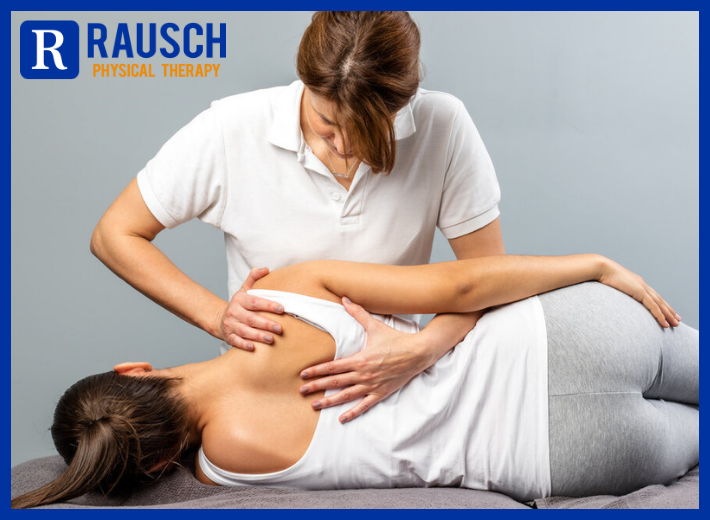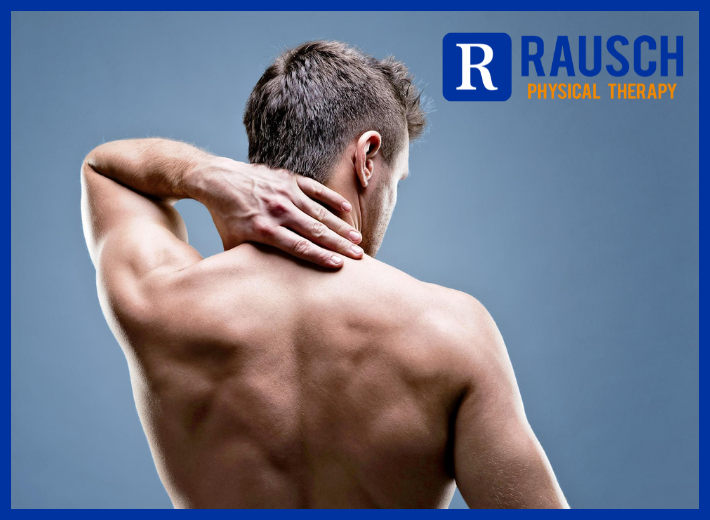Balancing a healthy diet and a consistent exercise routine can often feel like a complicated equation, but successful healthy living is truly about synergy, not sacrifice. The key to long-term,
6 Things That Can Cause Pain Between Your Shoulder Blades
December 2, 2021 6:06 pm / Category: Wellness

It is very common for a person to experience discomfort between their shoulder blades. You know it — we’ve all been there. Overuse, strains, sleeping awkwardly, and rotator cuff issues all fall into this category. These problems are often related to pain in the muscle groups surrounding the shoulders, including some of the arm muscles. Here’s why you may feel pain between your shoulder blades—and how to find relief from the discomfort. If you want assistance to get to the root cause of your issues — we are here!
Pain between shoulder blades
Whether it’s a dull ache or sharp spasm, pain between the shoulder blades can be a caused by a variety of things. It can be due to bad posture while staring at a computer screen all day, an exercise mishap, or an overuse injury.
Sometimes referred to as scapular pain—scapula is another name for your shoulder blade—it’s a common problem. According to a paper published in the Journal of the American Academy of Orthopaedic Surgeons, chronic shoulder pain affects about 8 percent of adults in the United States, and about 4.5 million Americans visit doctors about the condition every year.
Anatomy of the shoulder blade
Your shoulder blade, or scapula, connects to the clavicle (collar bone) and to the humerus (or upper arm bone).
This triangular-shaped bone also attaches to several muscles, including those of the rotator cuff. The rotator cuff muscles include four muscles—the teres minor, subscapularis, supraspinatus, and infraspinatus.
These are the muscles that help your shoulder abduct, like when you lift your arm, and internally and externally rotate the shoulder.
Also, around the shoulder blade, you’ll find muscles that support shoulder stability, including the levator scapulae, trapezius, rhomboids, and serratus anterior (which lies on the front of the body).
When to see a doctor
If you have tried improving your posture and you regularly strengthen and stretch the muscles of the upper body, yet you still have pain, it’s probably time to seek medical attention.
“Pain is meant to protect—it’s an output from the brain, based on the perception of threat,” explains physical therapist Colleen Louw, spokesperson for the American Physical Therapy Association and co-owner and lead physical therapist at Ortho Spine and Pain Clinic in Story City, Iowa.
If the brain senses something is off, it will alert you via pain to make a change. When that change doesn’t work, it’s time to get medical help.
A few other factors signal it’s time to talk to someone like pain at night that wakes you up or unexplained weight loss, says Louw.
Naimish Baxi, MD, assistant attending physiatrist at the Hospital for Special Surgery in New York City, says you want to see someone sooner rather than later if pain persists between the shoulder blades. A medical professional can help you avoid long-term problems. If the issue is musculoskeletal, they can give you a program for strengthening and stretching, too.
Common causes of pain between the shoulder blades
Your posture
“Posture is probably the biggest contributing factor to scapular pain,” Dr. Baxi says. How you sit and stand all day can definitely lead to discomfort between the shoulder blades and around the scapula, particularly if you’re in a forward-leaning position for hours.
Here are the particular issues that can arise from poor posture and how to both prevent and treat those issues.
What bad posture looks like
This condition stems from rounded shoulders and a C-curve in the upper spine. It includes a protracted, rather than retracted scapula, which means your shoulders round forward, instead of down your back and away from your ears. The neck also flexes forward and the shoulders internally rotate, Dr. Baxi explains.
“Sitting in this posture for hours a day and weeks on end can cause muscle imbalances,” Dr. Baxi says.
For example, the muscles on the front of the body (like the pecs or chest) get tight or overworked, and the muscles on the back of the body (like the rhomboids, mid traps, or the muscles of the rotator cuff) become weak or overstretched. This leads to discomfort and potentially more serious injury.
A typical seated position, especially when you’re looking at your phone or laptop, also causes the head to come forward, stressing the neck and upper traps. Because of this, the upper traps (which sit at the base of the neck and top of the shoulder) must stabilize the head—not their main job. Their primary role is to elevate or shrug the shoulders, Louw explains. This can lead to aches.
How to adjust your posture
For starters, sit actively, not passively, says Louw. By sitting forward on your seat and staying upright, you’ll avoid relaxing into a poor posture. Make sure you’re sitting on your two butt bones and are actively using your core to sit up straight, chest tall, with shoulders rolled down and back, away from your ears. Also, keep your head over your shoulders, not in front of them, Louw says.
Improving your work setup to make it more ergonomic will also help adjust your posture. According to Dr. Baxi, your computer screen should be at eye level and your keyboard close enough that you don’t have to reach for it. Your elbows should flex about 120 degrees.
Strengthening and stretching to avoid posture-related pain
You want to balance stretching the front of the body with strengthening the back of the body, says Dr. Baxi. “It’s even more important to strengthen than stretch,” he says. “You can stretch all day, but you won’t improve posture if you can’t get your muscles to activate on their own.”
For strengthening moves, focus on pulling exercises. A rowing machine can help you do this. Or try a reverse fly exercise, which stabilizes the muscles of the shoulders and strengthens the back. You want to perform moves that pull your shoulder blades together, as if you’re trying to hold a ball between them, Dr. Baxi says.
Other good-posture moves: chest openers and neck stretches to help offset muscle imbalances. To lengthen the neck muscles, take one hand on the opposite side of your head and gently pull toward the shoulder, Dr. Baxi suggests.
Nerve compression or damage
A seated, rounded posture can also lead to compression of the cervical spine (the neck region), leading to pain between the shoulder blades, Louw says.
Louw mentions that another possible cause of shoulder blade pain is thoracic outlet syndrome. This group of conditions results from compression on the blood vessels and nerves in the lower neck and upper chest. It can cause pain and weakness in the shoulder and tingling or pain in the fingers. There’s debate about what exactly causes this syndrome, which can be misdiagnosed because the symptoms look similar to rotator cuff injuries or other conditions.
Physical therapy can help treat the issue by guiding you in strengthening your chest and improving your posture.
Another nerve-related issue that can lead to pain is scapular winging, a condition in which one or more of the shoulder blades sticks out rather than laying flat against the body. But Dr. Baxi notes that it’s not very common.
Rotator cuff injuries
As previously mentioned, the rotator cuff is a group of muscles and tendons that surround the shoulder joint. The older you get, the more prone you become to rotator cuff tears, according to the Journal of the American Academy of Orthopaedic Surgeons paper, with people over 40 at greater risk.
These tears can come from overuse—think lifting or doing an activity that requires an overhead motion, such as painting. Tennis players and baseball pitchers, who constantly repeat the hitting and throwing motion, are also at higher risk of rotator cuff injuries.
If you suspect a rotator cuff injury, a doctor or physical therapist will give you a full assessment and treatment plan. Some of these injuries require surgery.
Herniated disc
Another condition that might cause pain between the shoulder blades is a herniated disc, Louw says. That’s particularly true of herniated discs that happen at the cervical spine (neck), which can lead to pain at the scapula.
Discs are soft, rubbery pads found between your vertebrae. They help make up the spine and work as shock absorbers. Age increases your chance of getting a herniated disc—a condition where the softer material inside the disc slips through it’s tough outer layer, sometimes compressing nerves and causing pain. Repetitive and intense exercise, or poor form while lifting weights, can also increase the risk of a herniated disc.
With a herniated disc, you might also experience weakness in the arm, tingling, or burning pain. And while occasionally it requires surgery, nonsurgical treatments like rest, over-the-counter pain relievers and anti-inflammatories, muscle relaxers, and ice may also help.
Scapulothoracic bursitis
Bursitis is a general term for conditions that cause swelling and pain around muscles and bones. A bursa is a small sac filled with fluid that cushions bones, muscles, tendons, and skin.
Repetitive movements (like overhead lifts or throws) can lead to bursitis, and the older you get, the more you’re at risk. Scapulothoracic bursitis refers to bursitis that affects the shoulder area.
Your doctor will do a full exam to look for bursitis. According to a 2010 research article, published in the journal Sports Health, addressing shoulder bursitis comes down to strengthening the scapula, fixing posture, and building core strength and endurance. Anti-inflammatory drugs may also help.
Gallbladder issues
The gallbladder is a tiny sac located under the liver that stores fat-digesting bile. Problems with your gallbladder can actually lead to shoulder or back pain. A study published in 2018 in the European Journal of Translational Myology found that about 37 percent of patients with gallstone disease complained of shoulder or back pain, though the most common complaint was abdominal pain.
Gallstones—or hard pieces of material often made up of cholesterol or bilirubin (a pigment made from the breakdown of red blood cells)—can develop in the gallbladder and block the bile ducts. This leads to sudden pain and requires immediate medical attention. The treatment for gallstones is most often surgery.
Push your limits and elevate your performance — and eliminate pain while increasing mobility — with a customized physical therapy program. Let us help you perfect your form and increase performance. Contact our experts today at (949) 276-5401 and join our Facebook community here. Remember, we also offer Rx Massage to enhance your PT treatments — and also to help when you get sore and to increase recovery from hearty exercise or race events.
Reference: [https://www.thehealthy.com/pain/pain-between-shoulder-blades/]






